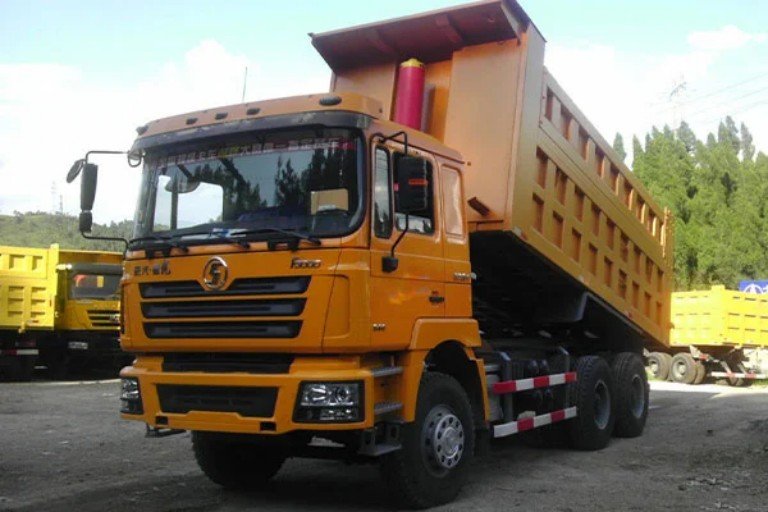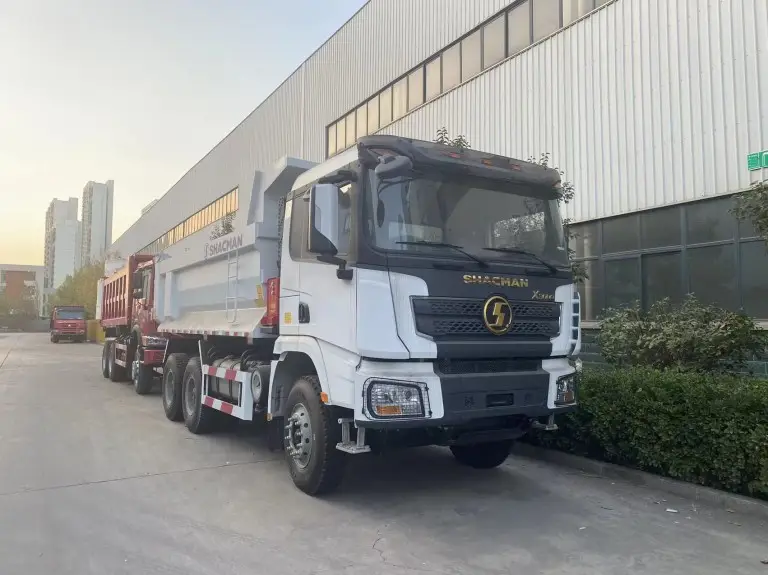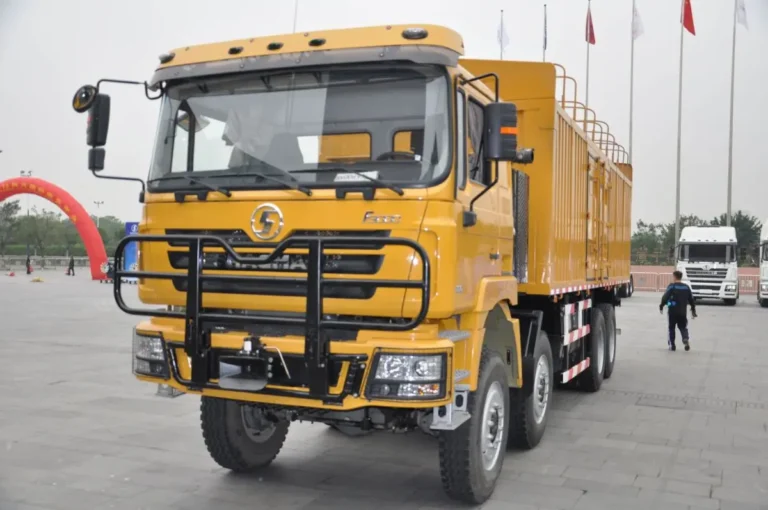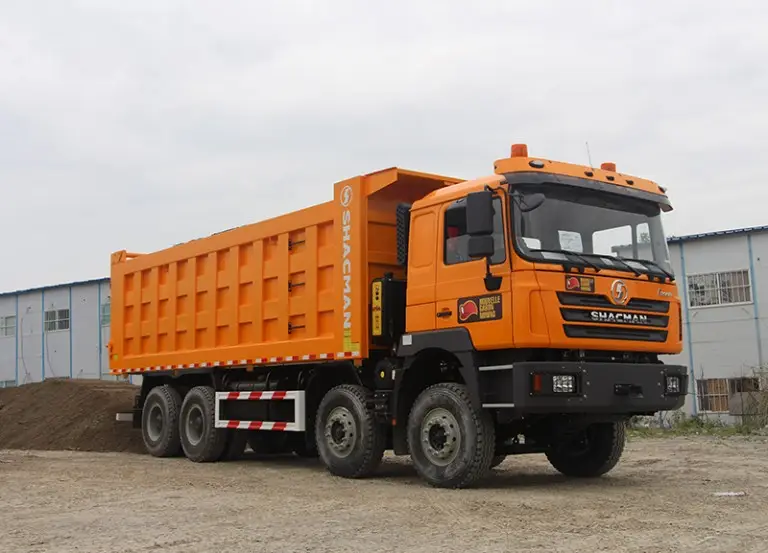The hydraulic system of Shacman dump trucks is the core of its efficient operation. It uses power provided by the engine to pressurize hydraulic oil, which is then delivered to the cylinders via control valves, achieving smooth lifting and unloading of the cargo box. This article will explain in detail the system components, working principles, common issues, and maintenance suggestions.
Table of Contents
Shacman Dump Truck Hydraulic System
The hydraulic lifting system of Shacman dump trucks is a hydrostatic transmission system characterized by low oil flow rate and high pressure. Its main structure includes power components, control components, execution components, auxiliary components, and working medium. As one of the core technologies of modern dump trucks, this hydraulic system plays a key role in achieving efficient lifting and unloading of goods.
The entire system uses the engine as the initial power source, and through the close collaboration of various components, it efficiently converts the energy of pressurized oil into the movement of the cargo box. Specifically, the power components are responsible for providing hydraulic energy, the control components regulate the system’s operating state, the execution components convert hydraulic energy into mechanical energy, and the auxiliary components ensure the system’s stability and reliability. Through this series of collaborative work, the hydraulic system achieves an efficient conversion process from power input to cargo box movement, providing strong support for the efficient operation of dump trucks.
Key Components of Shacman Dump Truck Hydraulic System
The efficiency and reliability of Shacman dump trucks largely depend on the quality and function of the hydraulic system components. The hydraulic system uses the engine as the power source, and through the collaborative work of core parts such as pumps, valves, and cylinders, it ensures efficient circulation and pressure control of the oil, thereby achieving smooth lifting and unloading of the cargo box.
Hydraulic Pump and Power Take-Off (PTO)
The hydraulic pump is the core component of the hydraulic system, responsible for converting mechanical energy into hydraulic energy. It is usually driven by a power take-off (PTO) connected to the truck’s engine. The PTO provides power to the hydraulic pump, ensuring the required pressure output for the system. Shacman dump trucks are equipped with high-performance hydraulic pumps that offer excellent durability and reliability, while the PTO unit is carefully designed to provide stable power support, ensuring smooth system operation.
Hydraulic Cylinder and Its Functions
The hydraulic cylinder is the key component that converts hydraulic energy into mechanical energy, responsible for driving the lifting and lowering of the cargo box. The hydraulic cylinders in Shacman trucks are made of high-strength materials, capable of withstanding high pressure and ensuring long-term durability. Their precise design provides smooth, controllable movement, adapting to various working conditions. However, hydraulic cylinder leaks are one of the common faults, accounting for 25% of total issues, so regular inspection and maintenance are crucial. During operation, the piston in the hydraulic cylinder extends under the action of pressurized oil, pushing the cargo box to tilt and achieving efficient unloading.
Control Valve and Operation Mechanism
The control valve plays a key role in regulating the flow direction of hydraulic oil in the hydraulic system. It directs the oil to the hydraulic cylinder, precisely controlling the lifting and lowering of the cargo box. The operation mechanism (such as levers and joysticks) provides operators with convenient management of the control valve. Shacman trucks are equipped with advanced control valve systems that enable precise flow regulation, ensuring safe and efficient operation.
Oil Tank and Hydraulic Oil Requirements
The oil tank is not only a reservoir for hydraulic oil but also plays a role in cooling and filtering within the system. Shacman trucks recommend using No. 46 L-HM anti-wear hydraulic oil, which complies with the ISO 11158 standard and is suitable for working environments from -10°C to 40°C, effectively extending system life and improving performance. The oil tank design includes baffles and return oil filters, which effectively remove contaminants and prevent oil foaming. Regularly checking the status of the oil tank and hydraulic oil is crucial for preventing system failures and extending equipment life.
| Component | Description | Importance |
|---|---|---|
| Oil Tank | Hydraulic oil reservoir and cooling system | High |
| Hydraulic Pump | Converts mechanical energy into hydraulic energy | High |
| Control Valve | Regulates hydraulic oil flow | High |
| Hydraulic Cylinder | Converts hydraulic energy into mechanical energy | High |
How the Shacman Dump Truck Hydraulic System Works?
The hydraulic system is the core technology of Shacman dump trucks, responsible for achieving the lifting and lowering of the cargo box. Its working principle is based on the efficient conversion of mechanical energy to hydraulic energy, which in turn drives the cargo box to complete heavy-load operations. The entire system uses the engine as the power source, and through the collaborative action of the hydraulic pump, control valve, and hydraulic cylinder, it ensures precise movement of the cargo box. The system is designed to be efficient and reliable, capable of meeting the demands of various harsh working conditions.
Detailed Explanation of the Lifting Process
The cargo box lifting process of Shacman dump trucks starts with the activation of the hydraulic pump. The hydraulic pump is driven by the truck engine’s power take-off (PTO), generating high-pressure hydraulic oil. Subsequently, the hydraulic oil is directed to the control valve and, after regulation, delivered to the hydraulic cylinder.
The hydraulic cylinder is usually arranged under the cargo box. When high-pressure oil enters the cylinder, it pushes the piston to extend, thereby lifting the cargo box. The control valve plays a key role in this process, ensuring smooth and controlled lifting of the cargo box through precise regulation of hydraulic oil flow. The entire process is efficient and reliable, capable of easily handling the lifting needs of heavy loads.
Detailed Explanation of the Lowering Process
The lowering process of the cargo box is achieved through the operation of the control valve. The operator switches the air control valve to the “lower” position, directing compressed air in the system to the piston of the lift valve. At this point, the piston pushes the valve core to move, connecting the high-pressure oil passage of the hydraulic cylinder to the return oil interface.
During the lowering process, the cargo box mainly relies on its own weight to push the hydraulic cylinder downward, and the hydraulic oil flows back to the oil tank through the control valve. The control valve ensures smooth and safe descent of the cargo box by limiting the oil flow speed. At the same time, the returning hydraulic oil passes through filters to remove contaminants, keeping the system clean and preparing for the next operation.
The hydraulic system of Shacman dump trucks achieves precise lifting and smooth lowering of the cargo box through the efficient collaboration of the engine, hydraulic pump, control valve, and hydraulic cylinder. Whether lifting heavy loads or safely unloading, the hydraulic system demonstrates excellent reliability and efficiency, providing strong support for various complex working conditions.
Different Lifting Mechanisms in Shacman Dump Trucks
Our Shacman dump trucks offer multiple lifting options, enhancing their practicality in various industries. We carefully evaluate customers’ operational requirements to determine the best mechanism. Some models also integrate safety elements, such as cushioning devices to mitigate vibrations and prevent overload situations.
Underbody Lifting Systems: “F” Type vs “T” Type
The underbody lifting system is the backbone of dump trucks, providing the force needed to lift the cargo box. We offer two main underbody lifting systems in Shacman dump trucks: “F” type and “T” type. The “F” type is renowned for its simplicity and reliability, suitable for a wide range of applications. On the other hand, the “T” type provides enhanced stability, prioritized for heavy-load operations. Both types are designed to provide high lifting angles, ensuring efficient unloading.
Front Push and Side Dump Systems
In addition to the standard underbody systems, we also offer Shacman dump trucks equipped with dedicated front push hydraulic systems and side dump systems. The front push system utilizes hydraulic push rods installed at the rear of the cargo box to push the goods forward. This system is particularly suitable for narrow spaces requiring controlled unloading. The side dump system enables precise placement of materials, making it ideal for applications such as road construction. Each system has unique advantages, and we evaluate based on customer needs to select the most appropriate one.
Conclusion
The hydraulic system is the backbone of any dump truck, and at HOWO Special Truck Ltd, we are here to guide you through the selection process. Our team takes pride in helping customers select the best hydraulic system for Shacman dump trucks based on their specific operational requirements and conditions. For cargo boxes smaller than 5.6 meters, we usually recommend the “F” type lifting system for its excellent performance and economy. For larger or heavier applications, our premium “T” type hydraulic system provides enhanced stability and safety. Investing in the right hydraulic system upfront can save significant maintenance costs over the truck’s lifespan, especially for construction machinery operating in demanding environments. In addition to selling trucks, we provide ongoing support for all hydraulic system components, ensuring your Shacman tipper truck remains reliable. We invite you to contact our team to discuss your specific needs – our professional service team will provide you with expert support.
FAQ
What is the main function of the hydraulic pump?
The hydraulic pump is the core component of the hydraulic system, driven by the power take-off (PTO), responsible for generating the pressure required to operate the hydraulic system. It converts mechanical energy into hydraulic energy, providing power support for the lifting and lowering of the cargo box.
How does the control valve regulate hydraulic pressure?
The control valve regulates the flow direction of pressurized hydraulic oil, directing the oil to the hydraulic cylinder, thereby controlling the lifting or lowering of the cargo box. By precisely adjusting the oil flow direction and pressure, the control valve ensures the smoothness and safety of cargo box operations.
What hydraulic oil is recommended?
Shacman dump trucks recommend using hydraulic oil that meets or exceeds the ISO 11158 standard, such as No. 46 L-HM anti-wear hydraulic oil (equivalent to AW46). Specific models can be referenced in the vehicle maintenance manual to ensure optimal performance and component life of the hydraulic system.
Why is the oil tank crucial?
The oil tank plays a key role in storing hydraulic oil, cooling, and filtering in the hydraulic system. It not only provides a stable oil supply to the system but also removes contaminants through filters, preventing system failures and ensuring the health and efficient operation of the hydraulic system.
What are the common causes of lifting issues?
Common causes of lifting issues in Shacman dump trucks include:
- Low hydraulic oil level
- Air in the system
- Control valve failure
- Decreased performance or failure of the hydraulic pump
By regularly checking hydraulic oil levels, bleeding air from the system, and maintaining key components, these issues can be effectively prevented and resolved.
How to handle oil leaks in the hydraulic system?
Steps to handle oil leaks include:
- Checking for damaged seals or hoses in the system
- Tightening loose connections
- Replacing any damaged components
Timely repair of leaks can prevent further damage and extend the service life of the hydraulic system.
What is the difference between “F” type and “T” type underbody lifting systems?
- “F” type lifting system: Suitable for standard dump truck operations, with a more universal design, ideal for daily cargo transportation.
- “T” type lifting system: Designed for specific heavy-load applications, providing higher stability and load-bearing capacity, suitable for complex working conditions and high-intensity operations.
Both systems are selected based on application needs to ensure optimal performance in different scenarios.




